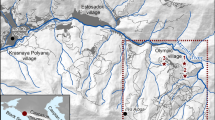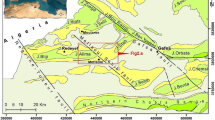Abstract
The current study focuses on roles of the synclines in building mountains of the Zagros Fold-Thrust Belt from Northeastern Iraq, Kurdistan Region. The studied area is located in the Imbricated Zone, which is a continuation of Simply Folded Zone of Iran. In some parts of this zone, the synclines contribute to building nearly half of the mountains and increase the relief contrast of the landscapes. The role of syncline in building mountains is opposite to its apparent intrinsic shape which is located in low land and normally forms synclinal valleys. In studied area, this phenomenon is observable in the areas that are complexly deformed, deeply exhumed, and predominately composed of the carbonate rocks. In these areas, exhumation and stream erosion have removed high thickness of overburden rocks and the tectonic stresses have crenulated carbonate rocks in the synclines. Due to these processes, these synclines are observable on the peak of the mountains now. The contribution of synclines in mountain building is related to three properties: the first is folding of synclines in confined condition (relative to anticlines) by which they have transformed to highly compact and stiff rocks. The second is accumulation of hydrothermal or meteoric water in the synclines due to its downward bending which aids precipitation of minerals and heals the possible tectonically and lithostatically induced fractures. The third is ductile deformation of synclines in confined and deeper level as compared to brittle deformation of anticlines in relatively shallower level and unconfined condition during deformation. Consequently, these factors result in an inversion of topography by which synclines are remained as mountains (high topography) above surface during exhumation while erosion removes anticlines. The result of this study is applicable for geological, geomorphological, and structural mapping in highly deformed and deeply exhumed terrains. The possible prediction of geomorphological position of synclines and anticlines on the mountain peaks and valley bottoms respectively is the applicable result in the above terrains.














Similar content being viewed by others
References
Alan W (1969) The crush zone of the Iranian Zagros Mountains, and its implications. Geol Mag 106:385–394
Alavi M (1994) Tectonics of the Zagros orogenic belt of Iran: new data and interpretations. Tectonophysics 229:211–238
Al-Khafaf AO (2014) Biostratigraphic contribution to the differentiation of the Lower-Middle Cretaceous units in the Imbricated Zone of Sulaimani Governorate, Kurdistan Region, NE Iraq, PhD thesis, University of Sulaimani
Al-Qayim B, Omer A, Koyi H (2012) Tectonostratigraphic overview of the Zagros suture zone, Kurdistan Region, Northeast Iraq. Geo Arabia 17(4):109–156
Ashjari J and Raeisi E (2006) Influences of anticlinal structure on regional flow, Zagros, Iran. J Cave Karst Stud 68(3):118–129
Blanc EJP, Allen MB, Inger S, Hassan H (2003) Structural styles in the Zagros Simple Folded Zone, Iran. J Geol Soc 160:401–412
Buday T (1980) Regional geology of Iraq, vol.1. stratigraphy: IIM Kassab and S Z Jassim (Eds) GEOSRVY. Min Invest Publ 445p
Buday T and Jassim SZ (1987) The regional geology of Iraq: tectonism magmatism, and metamorphism. II Kassab and MJ Abbas and SZ Jassim (Eds) GEOSURV, Baghdad, Iraq, 445 p
Carrapa B, Reyes-Bywater S, Safipour R, Sobel ER, Schoenbohm L, Reiners P, Stockli D (2014) The effect of inherited paleotopography on exhumation of the Central Andes of NW Argentina. Geol Soc Am Bull 126(1/2):66–77
Fossen H (2010) Structural geology. Cambridge University Press, Cambridge 463p
Fouad SFA (2014) Western Zagros Fold-Thrust Belt, part 2. Iraqi Bull Geol Min Special Issue, (6): 53–71https://www.researchgate.net/profile/Sharon_Bywater-Reyes/publication/270689656_The_effect_of_inherited_paleotopography_on_exhumation_of_the_Central_Andes_of_NW_Argentina/links/553a581d0cf245bdd7641364.pdf
François T, Agard P, Bernet M, Meyer B, Chung SL, Zarrinkoub MH, Burov E, Monié P (2014) Cenozoic exhumation of the internal Zagros: first constraints from low-temperature thermochronology and implications for the buildup of the Iranian plateau. Lithos 206–207:100–112
Gavillot Y, Axen GJ, Stockli DF, Horton BK, Fakhari MD (2010) Timing of thrust activity in the High Zagros fold-thrust belt, Iran, from (U-Th)/He thermochronometry. Tectonics TC4025 29:1–25
Ghafor IM, Karim KH, Baziany MM (2012) Age determination and origin of crenulated limestone in the eastern part of Sulaimaiyah Governorate, Kurdistan Region, NE-Iraq. Iraqi Bull Geol Min 8(2):21–30
Ghasemi A, Talbot CJ (2006) A new tectonic scenario for the Sanandaj–Sirjan Zone (Iran). J Asian Earth Sci 26:283–293
Guest B, Axen GJ, Lam PS, Hassanzadeh J (2006) Late Cenozoic shortening in the west central Alborz Mountains, northern Iran, by combined conjugate strike-slip and thin-skinned deformation. Geosphere 2:35–52
Handin J, Hager JRV (1957) Experimental deformation of sedimentary rocks under confining pressure: tests at room temperature on dry samples. AAPG Bull 41:1–50
Hessami K, Nilforoushan F, Talbot CJ (2006) Active deformation within the Zagros Mountains deduced from GPS measurements. J Geol Soc, London 163:143–148
Horne R, Culshaw N (2001) Flexural-slip folding in the Meguma Group, Nova Scotia, Canada. J Struct Geol 23(10):1631–1652
Jassim SZ, Goff JC (2006) Geology of Iraq. Dolin, Prague P. 241
Karim KH, Ahmad SH (2014) Structural analysis of the Azmir–Goizha anticline, north and northeast of Sulaimani city, Kurdistan Region, Northeast Iraq. J Zankoy Sulaimani—Part A (JZS-A) 16(1):45–68
Karim KH, Koyi H, Baziany MM, Hessami K (2011) Significance of angular unconformities between Cretaceous and Tertiary strata in the northwestern segment of the Zagros fold–thrust belt, Kurdistan Region, NE-Iraq. Geol Mag, Cambridge Univ Press 148(5–6):925–939
Karim KH, Sissakian VK, Al-Ansari N, Knutsson S (2014) Effect of the sun radiation on the asymmetry of valleys in Iraqi Zagros Mountain belt (Kurdistan Region). J Earth Sci Geotech Eng, Lulea Univ Technol, Sweden 4(2):23–32
Khanaqa PA, Karim KH, Riegel W (2014) Evidence of a Quaternary dammed Lake in the Mawat–Chwarta area evidence of a Quaternary dammed Lake in the Mawat–Chwarta area, Western Zagros, Kurdistan Region, NE-Iraq. CATENA 125:74–81
Lawa FA, Koyi H, Ibrahim A (2013) Tectono-stratigraphic evolution of the NW segment of the Zagros Fold–Thrust Belt, Kurdistan, NE Iraq. J Pet Geol 36(1):75–96
McQuarrie N (2004) Crustal scale geometry of the Zagros Fold–Thrust belt, Iran. J Struct Geol 26:519–535
Montgomery DR, Greenberg HM (2000) Local relief and the height of Mount Olympus. Earth Surf Process Landf 25:385–396
Montgomery DR, Stolar DB (2006) Reconsidering Himalayan river anticlines. Geomorphology 82:4–15
Nadimi A, Nadimi H (2008) Exhumation of old rocks during the Zagros collision in the northwestern part of the Zagros Mountains, Iran. Geol Soc Am Spec Pap 444:105–122
Ring U, Brandon MT, Willett SD (1999) Exhumation processes. Geol Soc Lond, Spec Publ 154:1–27
Sadeghi S, Yassaghi A (2015) Spatial evolution of Zagros collision zone in Kurdistan—NW Iran, constraints for Arabia–Eurasia oblique convergence. Solid Earth Discuss 7:2735–2773
Stöcklin J (1968) Structural history and tectonics of Iran: a review. Am Assoc Pet Geol Bull 52(7):1229–1258
Van Bellen R C , Dunnington HV, Wetzel R and Morton D (1959) Lexique Stratigraphique, International. Asia, Iraq, Fasc, 10a, Paris, 10a, 333p
Vergés J, Saura E, Casciello E, Fernàndez M, Villaseñor A, Jiménez-Munt I, García CD (2011) Crustal-scale cross-section across the NW Zagros Belt: implications for the Arabian Margin reconstruction. In: Lacombe O, Grasemann B, Simpson G (eds) Geodynamic Evolution of the Zagros, vol 148. Geological Magazine, Cambridge, pp 739–761
Author information
Authors and Affiliations
Corresponding author
Rights and permissions
About this article
Cite this article
Karim, K.H., Khanaqa, P.A. Syncline contribution to mountain peak building: examples from Western Zagros, Kurdistan Region, Northeastern Iraq. Arab J Geosci 10, 375 (2017). https://doi.org/10.1007/s12517-017-3163-1
Received:
Accepted:
Published:
DOI: https://doi.org/10.1007/s12517-017-3163-1




